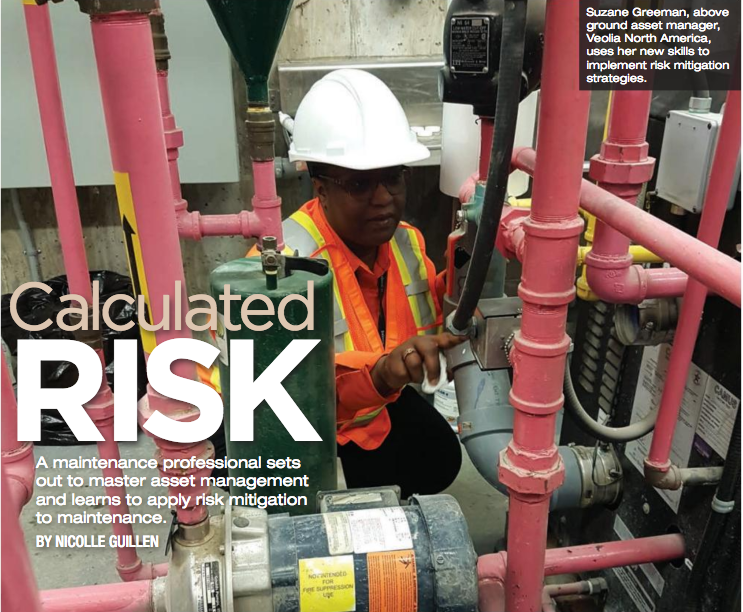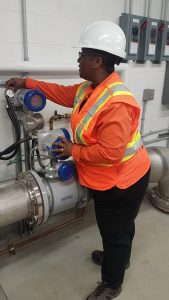
A maintenance manager builds her risk-management skills
Suzane Greeman is a seasoned maintenance professional who set out to master asset management and learned how to apply risk mitigation to maintenance.
June 23, 2017 | By Nicolle Guillen


Suzane Greeman explains equipment operations at Veolia North America.
A few years ago Suzane Greeman was working as a maintenance engineer in the cement industry but had a desire to learn more about how to care for the assets entrusted to her. She was searching for a way that was broader than simply maintenance and that could add value to her organization’s overall strategy.
“I started my career as an electrical and instrumentation technician and, since returning to school to complete my studies in electrical engineering, I have held various professional roles in maintenance, maintenance engineering, capital projects and even human resources,” says Greeman, who holds the CAMA, CAMP and CMRP designations.
“As a maintenance manager, I understood that risk is an everyday consideration. Maintenance experts need to ensure risks of failure is minimized, that maintenance planning and scheduling is accurate, and that plans are in place for when unexpected issues occur.”
But despite Greeman’s years of experience, she was not always sure how maintenance risk management plans fit into the bigger organizational plans. “I realized that maintenance wasn’t the only function in the organization, yet it has traditionally operated as a silo. Having been part of other departments in large organizations I could see that maintenance teams could become more efficient if they had insight into other strategies in the organization, and if they understood themselves as an integral part of an overall corporate strategy.”
Upgrading skills
Following an Internet search, Greeman came across the Plant Engineering and Maintenance Association of Canada’s Asset Management Professional certificate program offered through Humber College. PEMAC – a national not-for-profit association providing global leadership, education and certification in maintenance, reliability and asset management practices – designed the AMP program which is supported by a Skills Investment Fund grant from the Province of Ontario and influenced by a group of dedicated asset management experts from around the world. The AMP program encourages participants to explore leading-edge asset management frameworks of recognized global organizations and to apply them to their own work contexts.
“I wanted to take a deeper look into the relationship between asset management, maintenance management and other functional areas in the organization, and to gain a better understanding of ISO 55000x, the set of standards for Asset Management that were being developed at the time,” says Greeman. “The AMP program delivered the knowledge that I was craving. It is delivered in an online format that allowed me to participate from anywhere in the world, while at the same time benefiting from the vast experience of the other participants who were enrolled in the courses with me.”
Greeman embarked on the first of six courses in the AMP program in early 2015. After the third course “Risk Management and Performance Improvement,” which shows how the ISO 31000 Risk Management standards can be applied to support excellence in asset management, Greeman was beginning to see the important relationship between risk management and asset management.
Ron Gavrin, a retired manager from Ontario Power Generation (Nuclear) and the instructor in the Risk Management & Performance Improvement course, says, “The analysis and treatment of risks is a necessary component for any organization’s strategic asset management plan. Organizations that embrace this are able to maximize the value from their assets, and fully deliver on the objectives of the overall organizational strategic plan.”
But what is the role of an individual employee in an organizational-wide system? The AMP program, which attracts candidates from a variety of backgrounds, such as IT, engineering and business management, teaches the importance for asset-intensive organizations to have a well-developed Risk Management System (RMS) with a properly thought out Risk Framework driven from the corporate level. An asset management system should fit within and support the overall RMS, and maintenance functions should fit within and support an overall asset management system, says Greeman. “Thinking back to my maintenance engineering role, however, I realized that not all maintenance leaders work within a company that has a Risk Management System. Nor do they have direct control over policies and other strategies that come from most senior levels of an organization but this doesn’t mean there’s nothing they can do. As Ron taught us, ‘everyone has a responsibility to manage risk’.”
Risk management tools for maintenance
Greeman began to see how tools that she had used in maintenance roles in the past were actually risk management tools and that they clearly fit within a larger risk-management context. Also, since risk management concepts apply to analysis and decision-making across the whole sweep of the organization – sales, marketing, human resources management, asset management, capital projects, capital planning, maintenance and operations – she also saw that the language of risk management might help her to bridge silos (both horizontal and vertical) and contribute to more holistic decision making.
“The most important lesson I took from the program is that asset management practitioners should understand that their role is a part of a broader Risk Management approach of the organization. That together with the auditors, the management, and the Board, they form important lines of defense for the asset and the organization and are in fact a comprehensive part of the asset management strategy and plans.” These lines of defense may of course also include a Quality Management System, a Safety Management System and an Environmental Management System.
Today Greeman uses a holistic approach to Risk and Asset Management at Veolia North America in her new role as “Above Ground Asset Manager.” Veolia has 163,000 employees and provides solutions related to water, energy and materials, with a focus on waste recovery in order to promote the transition toward a circular economy. The firm is also well known for supporting municipalities and other industries around the globe to not only manage their assets, but to optimize them in every way. Greeman says that Veolia is providing an opportunity to practice asset management in its most powerful form, assisting Veolia and its customers to add value by managing and integrating every aspect of risk management into their overall performance.
On her journey, Greeman discovered that asset management not only provides a valuable approach to running an organization by ensuring that its assets deliver the most value, but that extracting value from assets also requires a deep understanding of the risks inherent in operating the assets.
As an example, Greeman describes a scenario in which the cement plant that she worked. The plant used a 4,500 Hp motor driving a ball mill via a clutch system. This mill delivered 60 per cent of the plant’s cement production at the time. “The mill was due for major repairs and the motor was approaching an overhaul as well, but we needed to get through a period of high-market demand and give the parts time to arrive on the island,” says Greeman. In response to a request from her general manager, Greeman developed a risk analysis methodology that examined the sub-assemblies and major components of the mill system, identified the risks, ranked them by likelihood, severity and detectability, developed mitigating actions and tested each action by doing a post-action risk ranking. “When we put our heads together as a multi-disciplinary team from Marketing, Maintenance, Production, Finance and Purchasing, the variety of risks surprised us as we were each only thinking about our own worlds. By executing this level of risk analysis, the mill’s performance exceeded our expectations.”
Asset management approach
After completing all six courses in the AMP program, Greeman qualified for the Certified Asset Management Professional designation from PEMAC. Greeman is proud of her CAMP certification, especially since she was immediately able to apply her learning to the asset management profession, and make an immediate contribution to her organization. She has a deeper understanding of the links between the functions that asset managers carry out and how they contribute to the organization.
“I now approach assets from a wider perspective. An asset management approach cuts across the organization, rather than a single department that is focused solely on lifecycle delivery,” says Greeman. “When the engineering team is able to interface effectively with maintenance team on asset condition, for example, then the appropriate refurbishment and replacement decisions will be taken. It is only then that the risks in the operating environment will be understood in a way that they can be mitigated.”
How to reduce risk – Suzane Greeman’s hit list
Suzane Greeman, above ground asset manager, Veolia North America, shares ways in which maintenance professionals can add value to their organization’s risk plan – even when having a seat at the table isn’t always possible. “This is by no means meant to be an exhaustive list, but represent a few examples of risk responses that maintenance managers usually have under their control and can apply to mitigate asset risks in full alignment with a corporate ISO 31000 Risk Management System,” she says.
- Reduce risks by contributing to maintenance readiness plans for capital projects ensuring that the maintenance organization and management systems are prepared to receive the new assets.
- Reliability Centered Maintenance (RCM) by implementing a Failure Mode Effect and Criticality Analysis (FMECA) to determine the appropriate maintenance strategy for the assets. This risk mitigating strategy can be applied at the asset acquisition stage for new assets or at the maintenance optimization stage for existing assets.
- Asset Condition Assessment enables the Asset Refurbishment and Replacement (ARR) decision-making process to be risk-based and data-centered, rather than a traditional wish list (ad hoc, loudest voice) type of process. Greeman is currently working on a project to implement Asset Condition Assessment in a way that it can be used to inform the ARR process.
- Equipment System Risk Analysis is achieved by incorporating an equipment risk analysis tool that Asset Managers can utilize to understand the risks facing critical equipment for which there is no immediate option of replacement or refurbishment. The risk analysis allows organizations to implement mitigating strategies that keep production running longer, when repairs might be time-consuming and expensive. As with project risks, the key element of the RSM is to ensure that the risks and the mitigating actions are well communicated using the appropriate Risk Register.
- Job Safety Analysis (JSA) that documents hazard analyses for specific jobs based on the nature of the work to be performed, the innate characteristics of the equipment or based on other known hazards that could be in the environs. This was a very effective tool that Suzane used while working with the Foremen to develop JSAs to analyze job risks & hazards via Toolbox Talks.
- Competence-based Training is not often recognized as a risk mitigating strategy. Incorporating training in a risk strategy equips maintenance staff to perform appropriate tasks in the correct manner, thereby protecting the assets from premature failure and under performance. It also equips asset-intensive organizations to nurture and maintain competencies and properly inform the recruitment processes.
Nicolle Guillen is the professional development manager for PEMAC, a national not-for-profit association providing global leadership, education and certification in maintenance, reliability and asset management practices. For more information, visit www.pemac.org.
